
The Angara is a major river in Siberia, which traces a course through Russia's Irkutsk Oblast and Krasnoyarsk Krai. It drains out of Lake Baikal and is the headwater tributary of the Yenisey. It is 1,849 kilometres (1,149 mi) long, and has a drainage basin of 1,039,000 square kilometres (401,000 sq mi). It was formerly known as the Lower or Nizhnyaya Angara. Below its junction with the Ilim, it was formerly known as the Upper Tunguska and, with the names reversed, as the Lower Tunguska.

The Dnieper Hydroelectric Station, also known as the Dnipro Dam, is a hydroelectric power station in the city of Zaporizhzhia, Ukraine. Operated by Ukrhydroenergo, it is the fifth and largest station in the Dnieper reservoir cascade, a series of hydroelectric stations on the Dnieper river that supply power to the Donets–Kryvyi Rih industrial region. Its dam has a length of 800 metres (2,600 ft), a height of 61 metres (200 ft), and a flow rate of 38.7 metres (127 ft) per second.

Bratsk Reservoir (Russian: Братское водохранилище, romanized: Bratskoye vodokhranilishche) is a reservoir on the Angara River, located in the Lena-Angara Plateau of Irkutsk Oblast, Russia. It is named after the city of Bratsk, the largest city adjacent to the reservoir. It has a surface area of 5,470 square kilometres (2,110 sq mi) and a maximum volume of 169.27 × 1012 litres (37.2 × 1012 gallons).

The Bratsk Hydroelectric Power Station is a concrete gravity dam on the Angara River and adjacent hydroelectric power station. It is the second level of the Angara River hydroelectric station cascade in Irkutsk Oblast, Russia. From its commissioning in 1966, the station was the world's single biggest power producer until Krasnoyarsk Hydroelectric Power Station reached 5,000 MW in 1971. Annually the station produces 22.6 TWh. Currently, the Bratsk Power Station operates 18 hydro-turbines, each with capacity of 250 MW, produced by the Leningrad Metal Works in the 1960s.
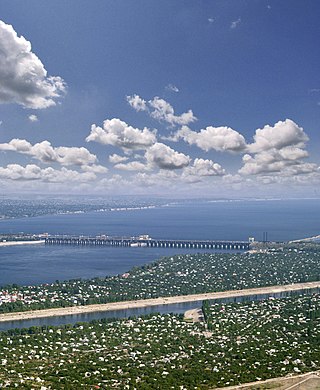
The Volga Hydroelectric Station or Volga GES also known as the 22nd Congress of the CPSU Stalingrad/Volgograd Hydroelectric Power Station, is the largest hydroelectric station in Europe, and it is the last of the Volga-Kama Cascade of dams, immediately before the Volga River flows into the Caspian Sea. It was the largest powerstation in the world between 1960 and 1963. Today, it is operated by the electricity company RusHydro.
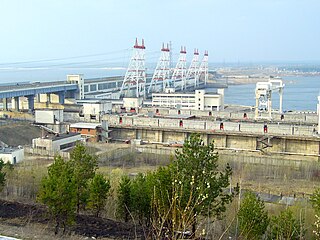
The Cheboksary Dam is a hydroelectric dam on the Volga river, the latest of the Volga-Kama Cascade of dams.
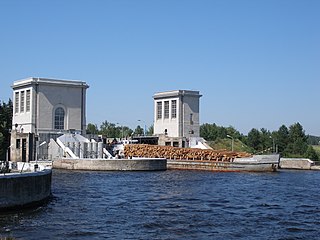
The Nizhny Novgorod Hydroelectric Station or Nizhny Novgorod GES is a hydroelectric station on the Volga river. Located near Zavolzhye, Nizhny Novgorod Oblast, it belongs to the Volga-Kama Cascade of dams.
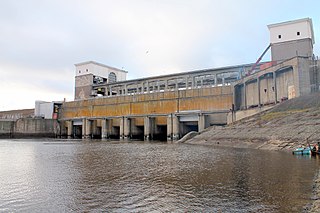
Rybinsk Hydroelectric Station or Rybinsk GES is a hydroelectric station on the Volga and the Sheksna rivers in Yaroslavl Oblast near the Rybinsk town. it is the third of the Volga-Kama Cascade of dams.
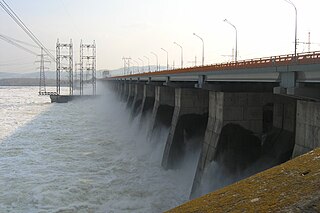
The Zhiguli Hydroelectric Station or Zhigulyovskaya Hydroelectric Station, formerly known as Kuybyshev Hydroelectric Station is a large dam and hydroelectric station on the Volga River, located near Zhigulyovsk and Tolyatti in Samara Oblast of Russia. It is the sixth stage of the Volga-Kama Cascade of dams, and the second of them by installed power.

The Fierza Hydroelectric Power Station is a large hydroelectric power station on the Drin River, in Albania.

The Boguchany Dam is a large hydroelectric dam on the Angara River in Kodinsk, Krasnoyarsk Krai, Russia. It has an installed capacity of 2,997 MW. Construction of the power plant was completed when a ninth and final generator was brought online in January 2015.

Deriner Dam is a concrete double-curved arch dam on the Çoruh River 5 km (3.1 mi) east of Artvin in Artvin Province, Turkey. The main purpose of the dam is hydroelectric power production and additionally flood control. Construction on the dam began in 1998, the reservoir began to fill in February 2012 and the power station was completed by February 2013. It will have a 670 MW power house and is the tallest dam in Turkey. The dam is being implemented by Turkey's State Hydraulic Works and constructed by a consortium of Turkish, Russian and Swiss companies.

The Ust-Ilimsk Hydroelectric Power Station is a concrete gravity dam on the Angara River and adjacent hydroelectric power station. It is located near Ust-Ilimsk, Irkutsk Oblast in Russia and is the third dam on the Angara cascades. Construction of the dam began in 1963, its reservoir began to fill in 1974, and the power plant was commissioned in 1980.
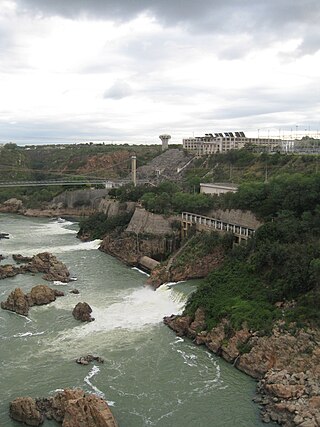
The Paulo Afonso Hydroelectric Complex, also known as the Paulo Afonso Complex, is a system of three dams and five hydroelectric power plants on the São Francisco River near the city of Paulo Afonso in Bahia, Brazil. The complex exploits an 80-metre (260 ft) natural gap on the river, known as the Paulo Afonso Falls. Constructed in succession between 1948 and 1979, the dams support the Paulo Afonso I, II, III, IV and Apollonius Sales (Moxotó) power plants which contain a total of 23 generators with an installed capacity of 4,279.6 megawatts (5,739,000 hp).
The Baishan Dam is an arch-gravity dam on the Second Songhua River near the town of Baishanzhen, Huadian, Jilin Province, China. The purpose of the dam is hydroelectric power generation and flood control. The dam supplies water to five turbine-generators in two different powerhouses for an installed capacity of 1,500 megawatts (2,000,000 hp) while it can also control a design 19,100 cubic metres per second (670,000 cu ft/s) flood. Additionally, it has a 300 megawatts (400,000 hp) pumped-storage hydroelectric generation capacity. It is named after Baekdu Mountain, near the city of Baishan.

Pavlovka hydroelectric station is a power station located near the village Pavlovka on the Ufa River in Bashkortostan. Construction of the power station began in 1950 and was completed in 1960. The power station is owned and operated by Bashkirenergo.

Stave Falls Dam is a dual-dam power complex on the Stave River in Stave Falls, British Columbia, Canada. The dam was completed in 1912 for the primary purpose of hydroelectric power production. To increase the capacity of Stave Lake, the dam was raised in 1925 and the Blind Slough Dam constructed in an adjacent watercourse 500 m (1,600 ft) to the north, which was the site of the eponymous Stave Falls. In 2000, the dam's powerhouse was replaced after a four-year upgrade. The original Stave Falls powerhouse was once British Columbia's largest hydroelectric power source, and is a National Historic Site of Canada.
The Malutang Dam is a concrete-face rock-fill dam (CFRD) on the Panlong River in Malipo County, Yunnan Province, China. The primary purpose of the dam is hydroelectric power generation and the power plant was constructed in two stages. Stage I consists of a 40 m (131 ft) tall gravity dam which diverted water through a 3,460 m (11,352 ft) long tunnel to a 100 MW above ground power station downstream. Construction on Stage I began in 2002 and the first of 50 MW Francis turbine-generators was commissioned in October 2004, the second in January 2005.
The Daguangba Dam is a multi-purpose dam on the Changhua River in Hainan Province, China. It is located 35 km (22 mi) east of Dongfang. As the primary component of the Daguangba Multipurpose Project, the dam was constructed between 1990 and 1995. It serves to provide water for both hydroelectric power generation and agriculture. It supports a 240 MW power station and supplies water for the irrigation of 12,700 ha. It is also the largest dam and hydroelectric power station in Hainan.
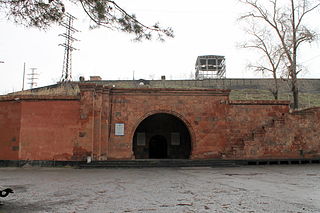
Sevan–Hrazdan Cascade is a complex of hydroelectric power plants on the Hrazdan River and its tributaries between the Lake Sevan and Yerevan in Armenia. They use irrigation water flow from the Lake Sevan and streams waters of Hrazdan River. The cascade is owned by the International Energy Corporation (IEC), a subsidiary of Tashir Group owned by Samvel Karapetyan.



















